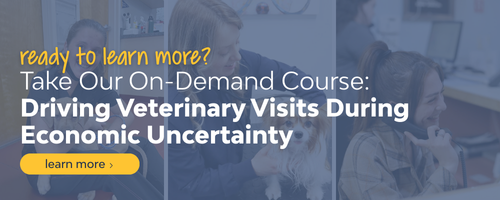By Brenda Tassava Medina, CVPM, CVJ, MVLCE
We’re all feeling it.
Clients are hesitating. Visits are shifting. And the pressure to grow revenue is mounting in the background of a world that feels economically upside down.
But here’s the truth I want every veterinary leader and team member to understand:
Even in times of economic uncertainty, clients still love their pets. They still want to do the right thing. They just need our help getting there.
1. Reframe the Value of Veterinary Care
When clients are watching every dollar, we have to do more than list services—we have to tell the story of outcomes.
Instead of: “Your dog needs a dental…It’s $625”
Say: “We’re seeing early signs of dental disease. If we treat this now, we can prevent pain, infection, and a bigger procedure later. This is how we protect their energy and appetite—so they stay happy and playful at home.”
You’re not recommending dental cleaning. You’re advocating for comfort, longevity, and joy.
2. Talk About Affordability Without Shame
Money is emotional. For our clients and our teams.
Train your team to lead financial conversations with clarity and compassion:
“Let’s talk through what’s most important today and how we can make it work for your budget.”
“We can prioritize care based on your goals and spread the rest out if needed.”
Confident teams create confident clients…and confident clients say “yes” to care.
3. Build an Affordable Access Toolkit
Here are some options you can use or offer that make care more accessible:
Good/Better/Best Tiers
This is a pricing and service model that offers clients multiple levels of care based on value and budget.
- Good = essential services only
- Better = core services plus added benefits (e.g., diagnostics)
- Best = comprehensive care, including follow-ups or upgraded products
It empowers clients to make informed choices and say “yes” to what fits their priorities without feeling pressured.
Membership & Subscription Plans
Think of these like “Netflix for vet care”: predictable monthly payments in exchange for routine, preventive services like exams, vaccines, and diagnostics.
They build loyalty, improve compliance, and reduce financial surprises by spreading costs out over time. Great for both client retention and practice revenue stability.
In-House Payment Platforms
These are tools like VetBilling that allow practices to offer monthly payment plans internally.
They work by automatically processing payments on a schedule while the practice maintains control over plan structure and terms.
This increases access to care without relying on external credit checks.
Third-Party Credit
Options like CareCredit allow clients to apply for financing through an outside lender.
These platforms typically offer short-term no-interest plans or longer-term options with interest. They’re useful for high-cost procedures and allow the practice to be paid up front while giving clients more time to pay.
Loyalty Programs
Loyalty programs reward clients for consistent care or repeat visits. Clients might earn points for every dollar spent or receive credits for services like wellness exams, vaccines, or dental cleanings.
These programs encourage return visits, increase compliance, and deepen the client-practice relationship.
Affordability isn’t always about price, it’s about flexibility.
4. Offer Access Clients Can Rely On
Ask yourself:
Are we open evenings or weekends?
Do we have same-day or urgent care availability?
Can we follow up with clients about finances outside appointment time?
You don’t need to offer 24/7 services to win. You just need to be available when it counts and communicate that availability clearly.
5. Leverage Technicians to Streamline and Rebuild Capacity
We’re still seeing 30–40-minute appointments post-COVID, but that’s not sustainable.
Instead:
- Use techs and assistants fully through training and delegation
- Automate intake with digital forms your team collects prior to appointment arrival times
- Try AI-powered scribing tools to save yourself from duplicate work
A return to 20-minute efficiency doesn’t mean rushing, it means designing appointments that make the most of every role.
6. Engage Gen Z with Messaging That Resonates
Gen Z is the largest group of new pet owners, and they value:
- Transparency or recommendations and pricing
- Accessibility to care
- Social values in line with their own
- Personalization for their pet and family
Reach them through:
- Instagram Reels
- TikTok
- YouTube Shorts
And don’t forget your website! Use polls, quizzes, and interactive tools to personalize the experience.
7. Measure What Matters Most
Move beyond average transaction value. Consistently track:
- Frequency of care
- Lifetime value
- Client satisfaction
Ask yourself and your team: “Are pets coming back often enough? Are clients staying long-term? Are they happy?”
That’s how you build sustainable growth.
8. Don’t Be Afraid to Ask, “Why Did You Choose Us?”
Whether it’s your intake form or check-in conversation, ask: “What made you choose our practice?”
The answers reveal what’s working in your marketing, access, and messaging, and what to do more of.
Final Thought: Lead With Your Heart, Not Fear
Yes, economic uncertainty is real. But your responses don’t have to be fear-based.
Reframe value. Make care accessible. Be proactive.
Because when we design for trust, empathy, and flexibility, clients say yes. Not just once, but for the life of their pet.






